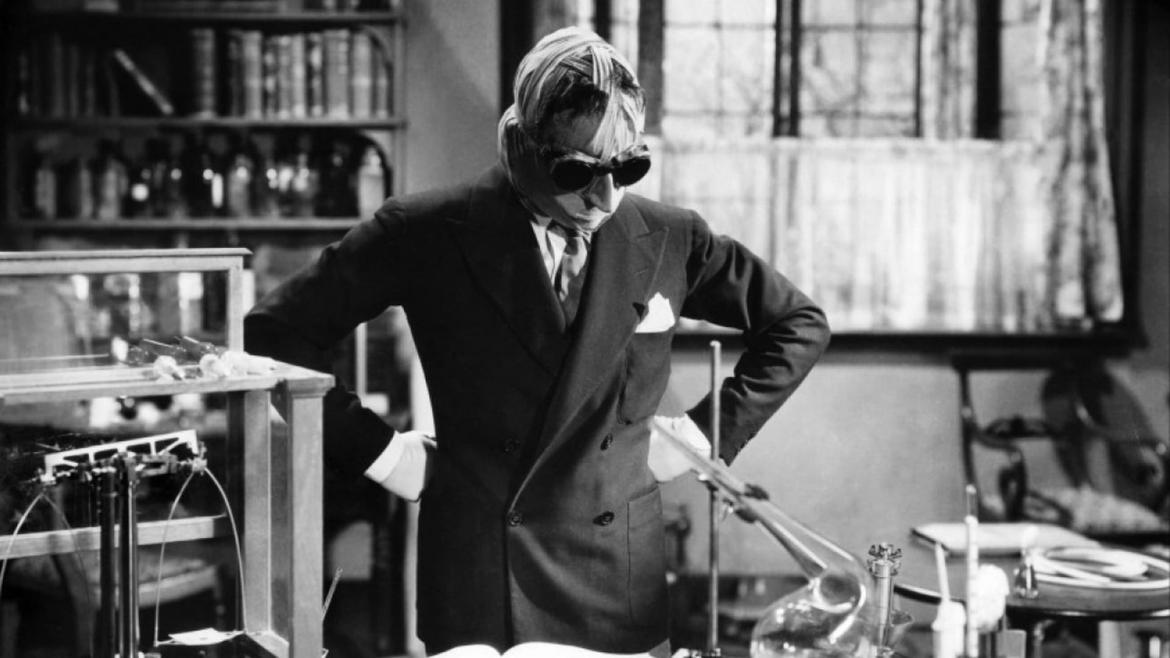
The Invisible Man (Movie Review)
The legendary Universal Horror cycle of the earlier to mid 1930s is a period in cinema all cinephiles owe it to themselves to explore. Certainly variants of horror myth and folklore were present in the cinema prior to this. Most famously we can think of Nosferatu or any number of German Expressionist films from earlier in the century as well as the early silent version of Frankenstein. However, for many film historians Tod Browning’s 1931 Dracula and James Whale’s Frankenstein from the same year ushered in “horror” as a very specific genre in Hollywood filmmaking.
Robert Spadoni in his book “Uncanny Bodies: The Coming of Sound Film and the Origins of the Horror Genre” argues that while earlier Hollywood films experiment with the affective powers of sound, Dracula and Frankenstein are films that fully solidified not only what a horror film was about, looked and sounded like but also how an audience responded to it. But while Frankenstein, Dracula, and other films from that period have become more emblematic of a classical horror cinema, The Invisible Man, another James Whale film, stands as a unique albeit slightly uneven piece of horror history.
Based on H.G. Wells’ novella of the same title, the film tracks the chaotic rampage of Dr. Jack Griffin (Claude Rains), a young scientist who has recently turned himself invisible with the aid of a rare and dangerous drug which has the unfortunate side effect of sending whoever is exposed to it into a mad rage. The film begins as Griffin, covered in bandages, trudges through the snow. He places himself in the seclusion of a small village inn where he works on an antidote to reverse his condition. Meanwhile, we are introduced to Griffin’s employer Dr. Cranley (Henry Travers) and his daughter Flora (Gloria Stuart), who also happens to be Griffin’s requisite love interest. The pair worry over the man’s absence, concerned for his safety, while Griffin’s coworker Dr. Kemp (William Carrigan) uses his absence to confess his feelings for Flora, begging her to forget about the demented scientist. But like so many female characters involved with slightly crazed megalomaniac scientists, Flora cannot help but stand by her man.
Griffin begins to exhibit increasingly antisocial behavior and after a few weeks at the inn, he is asked to leave. Confronted with eviction, Griffin loses control and reveals his invisibility to the town. It’s a sequence that juggles hilarity, genuine creepiness, and abrupt violence quite brilliantly. His actions are at first childish enough, leaving only superficial injuries and providing Whale with the opportunity to insert some inventive in-camera effects as timeless as the films of Georges Méliès. Griffin’s antics become increasingly more violent, eventually leading to the deaths of several people and the derailment of a train. As his desire for power deepens, Griffin takes Kemp hostage and forces him to assist him in taking over the world with a “reign of terror.”
The Invisible Man is a horror film that comes at an interesting period in American cinema. Though the use of electronic soundtracks had been institutionalized and accepted by 1931, Whale expresses a great playfulness for the humorous novelty of disembodied voices. A number of sequences involve radio broadcasts and montage sequences that either combine or end with Griffin’s voice. One patron of a tavern is viewed playing a piano. As he turns to take a bow, another patron inserts a coin into the piano, causing it to spring to life as the patron turns to pantomime playing. Indeed, the audience most likely would not have as keenly experienced the affective quality of an invisible antagonist if it were not for sound technology.
Secondly, having been produced prior to the full institution of the production code the violence in the film is certainly brutal and intense. We witness the fiery derailment of a train resulting in the deaths of all the passengers. One person is locked in a car and pushed over a cliff, the vehicle seen crashing into rocks and exploding. A policeman is strangled and beaten to death and a few townspeople are pushed off a cliff. While the explicitness of the violence may appear relatively sterile by today’s standards, it is important to remember how shocking and sensational this would have seemed to the film’s contemporaneous audiences. Then there is the comedic violence that Whale uses with his signature campish slant. Some of the scenes in which Griffin attacks policemen are actually quite humorous and verge on vaudeville comedy. At one point, we watch Griffin attack a policeman, removing his pants. Then the scene cuts to a woman screaming, running down a forested path. Soon we hear Griffin’s voice signing “Pop! Goes the Weasel!” as the policeman’s trousers are viewed skipping down the street. This is some of the brilliance of Whale’s direction. His ability to both construct scares and elicit shocks is equally matched and balanced by scenes of comedy.
Coming just a few years prior to Bride of Frankenstein, the The Invisible Man marks a point when Whale very deliberately injects camp into some seemingly stern material. The fact that we do not see the Invisible Man being made seems to indicate Whale’s interest not in the pursuits of science and the dangers of hubris — though there are a few cautionary lines for good measure — but in the act of making and viewing cinematic illusions. The Invisible Man may not be a timeless, revolutionary piece of cinematic art, but it is a film ingrained with curiosity about the cinema as a medium.

